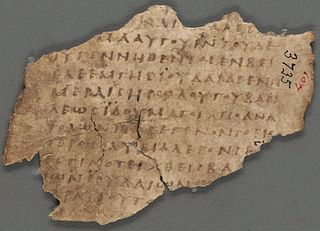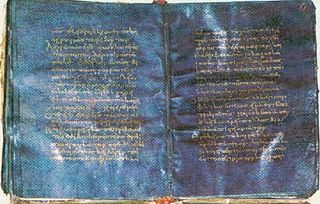In textual criticism of the New Testament, the Western text-type is one of the main text types. It is the predominant form of the New Testament text witnessed in the Old Latin and Syriac Peshitta translations from the Greek, and also in quotations from certain 2nd and 3rd-century Christian writers, including Cyprian, Tertullian and Irenaeus. The Western text had many characteristic features, which appeared in text of the Gospels, Book of Acts, and in Pauline epistles. The Catholic epistles and the Book of Revelation probably did not have a Western form of text. It was named "Western" by Semmler (1725–1791), having originated in early centers of Christianity in the Western Roman Empire.

Codex Koridethi, also named Codex Coridethianus, designated by siglum Θ or 038, ε050, is a Greek uncial manuscript of the New Testament, written on parchment. Using the study of comparative writing styles (palaeography), it has been assigned to the 9th century CE. The manuscript has several gaps.

Codex Washingtonianus, Codex Washingtonensis or Codex Freerianus, designated by W or 032, ε014, also called the Washington Manuscript of the Gospels, The Freer Gospel and The Freer Codex, is a Greek uncial manuscript of the four Gospels, written on parchment. Using the study of comparative writing styles (palaeography), it has been dated to the 4th or 5th century. The manuscript has some gaps.
Family 13, also known as the Ferrar Group, is a group of Greek Gospel manuscripts, dating from the 11th to the 15th centuries, which share a distinctive pattern of variant readings. All are thought to derive from a lost majuscule Gospel manuscript, probably from the 7th century. The group takes its name from minuscule 13, now in Paris.

Papyrus 45, designated by siglum 𝔓45 in the Gregory-Aland numbering of New Testament manuscripts, is an early Greek New Testament manuscript written on papyrus, and is one of the manuscripts comprising the Chester Beatty Papyri, a group of early Christian manuscripts discovered in the 1930s, and purchased by business man and philanthropist, Alfred Chester Beatty. Beatty purchased the manuscript in the 1930s from an Egyptian book dealer, and it was subsequently published in The Chester Beatty Biblical Papyri, Descriptions and Texts of Twelve Manuscripts on Papyrus of the Greek Bible by palaeographer, biblical and classical scholar Frederic G. Kenyon in 1933. Manuscripts among the Chester Beatty Papyri have had several places of discovery associated with them, the most likely being the Faiyum in Egypt. Using the study of comparative writing styles (palaeography), it has been dated to the early 3rd century CE. This therefore makes it the earliest example of not only the four Gospels contained in one volume, but also the Acts of the Apostles. It contains verses in fragmentary form from the texts of Matthew chapters 20–21 and 25–26; Mark chapters 4–9 and 11–12; Luke chapters 6–7 and 9–14; John chapters 4–5 and 10–11; and Acts chapters 4–17.

Codex Basilensis, designated by Ee, 07 or ε 55, is a Greek uncial manuscript of the four Gospels, dated paleographically to the 8th century.

Family 1 is the name given to a group of Greek New Testament minuscule manuscripts of the Gospels, identified by biblical scholar Kirsopp Lake. These manuscripts vary in date from the 12th to the 15th century. The group takes its name from minuscule codex 1, now in the Basel University Library, Switzerland. "Family 1" is also symbolized as ƒ1 in critical editions of the Greek New Testament. Textual-critic Hermann von Soden refers to the group as Iη. Though initially named after minuscule 1, later studies have demonstrated that another minuscule, minuscule 1582, is likely a better candidate as a representation of the archetype from which the Family 1 manuscripts are descended.

Codex Regius, designated by siglum Le or 019, ε56, is a Greek uncial manuscript of the New Testament written on parchment. Using the study of comparative writing styles (palaeography), it has been assigned to the 8th century. The manuscript has several gaps. Textual critic Frederick H. A. Scrivener described it as "by far the most remarkable document of its age and class."

Codex Sangallensis, designated by Δ or 037, ε76, is a Greek-Latin diglot uncial manuscript of the four Gospels. Using the study of comparative writing styles (palaeography), it is usually dated to the 9th century CE, though a few palaeographers would place it in the 10th century CE. It was given its current name by biblical scholar Johann Martin Augustin Scholz in 1830.
The Codex Athous Laurae, designated by Ψ or 044, or δ 6, is a manuscript of the New Testament written in Greek uncial letters on parchment. The manuscript has many gaps in the text, as well as containing handwritten notes. Using the study of comparative writing styles (palaeographically), the codex is dated to the 8th or 9th century.

Uncial 071, ε 015 (Soden), is a Greek uncial manuscript of the New Testament, dated paleographically to the 5th or 6th century. It came from Oxyrhynchus.

Minuscule 565, ε 93 (Soden), also known as the Empress Theodora's Codex, is a Greek minuscule manuscript of the New Testament, written on purple parchment, dated palaeographically to the 9th century. It was labelled by Scrivener as 473. The manuscript is lacunose. It has marginalia.
Minuscule 892, ε 1016 (Soden). It is a Greek minuscule manuscript of the New Testament, on 353 parchment leaves. It is dated palaeografically to the 9th century.

Minuscule 700, ε 133, is a Greek New Testament minuscule manuscript of the Gospels, written on parchment. It was formerly labelled as 604 in all New Testament manuscript lists, however textual critic Caspar René Gregory gave it the number 700. Using the study of comparative writing styles (palaeography), it has been dated to the 11th century. It is currently housed at the British Library in London.
Textual variants in the New Testament manuscripts arise when a copyist makes deliberate or inadvertent alterations to the text that is being reproduced. Textual criticism of the New Testament has included study of its textual variants.
Codex Sinaiticus and Codex Vaticanus, two of the great uncial codices, representatives of the Alexandrian text-type, are considered excellent manuscript witnesses of the text of the New Testament. Most critical editions of the Greek New Testament give precedence to these two chief uncial manuscripts, and the majority of translations are based on their text. Nevertheless, there are many differences between these two manuscripts. A recent scientific comparative study of interest published on these two Alexandrian codices is "The Relationship between Vaticanus & Sinaiticus and the Majority Text in Galatians" by Dr. Graham G. Thomason and "THE SIGNIFICANCE OF SPLIT TEXT-TYPES FOR THE RECOVERY OF THE ORIGINAL TEXT OF THE GREEK NEW TESTAMENT" by Dr LESLIE McFALL - both are freely made available on the internet. Historically, the true character of these two Alexandrian manuscripts was quickly and thoroughly challenged by Dean John William Burgon's exhaustive analysis: "It is in fact easier to find two consecutive verses in which these two MSS differ the one from the other, than two consecutive verses in which they entirely agree."
Textual variants in the Gospel of Mark are the subject of the study called textual criticism of the New Testament. Textual variants in manuscripts arise when a copyist makes deliberate or inadvertent alterations to a text that is being reproduced. An abbreviated list of textual variants in this particular book is given in this article below.
Textual variants in the Gospel of Luke are the subject of the study called textual criticism of the New Testament. Textual variants in manuscripts arise when a copyist makes deliberate or inadvertent alterations to a text that is being reproduced. An abbreviated list of textual variants in this particular book is given in this article below.
Textual variants in the Gospel of John are the subject of the study called textual criticism of the New Testament. Textual variants in manuscripts arise when a copyist makes deliberate or inadvertent alterations to a text that is being reproduced. An abbreviated list of textual variants in this particular book is given in this article below.
Textual variants in the First Epistle to Timothy are the subject of the study called textual criticism of the New Testament. Textual variants in manuscripts arise when a copyist makes deliberate or inadvertent alterations to a text that is being reproduced. An abbreviated list of textual variants in this particular book is given in this article below.










